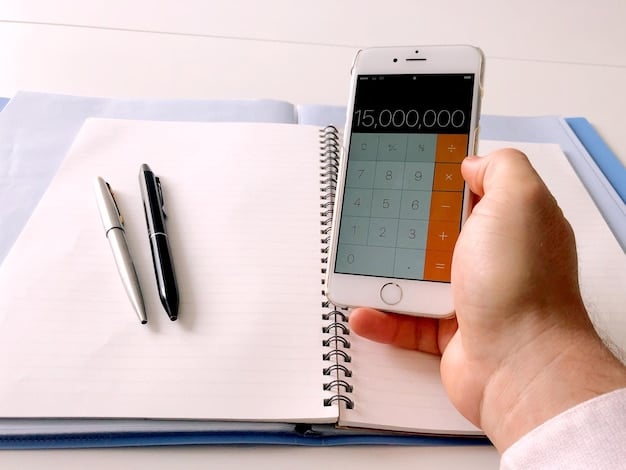Track Your Expenses & Dominate Your Budget in 30 Days

Tracking your expenses is crucial for gaining control of your budget, allowing you to identify spending patterns, cut unnecessary costs, and achieve your financial goals within the next 30 days by making informed financial decisions.
Are you feeling lost when it comes to your finances? Do you want to take control of your spending and achieve your financial goals? The answer might be simpler than you think: tracking your expenses. In the next 30 days, you can transform your financial health by understanding where your money goes and making informed decisions about your spending habits.
Why Tracking Your Expenses Is Essential
Tracking your expenses might seem like a tedious task, but it’s a fundamental step towards financial freedom. It provides a clear picture of your spending habits, allowing you to identify areas where you can save money and make smarter financial choices. Let’s explore the key reasons why this practice is so important.
Understanding Your Spending Habits
One of the primary benefits of tracking your expenses is the ability to understand where your money is actually going. Many people are surprised to discover that small, seemingly insignificant purchases add up to a significant amount over time. By tracking every dollar spent, you can gain a comprehensive view of your financial behavior.
Identifying Unnecessary Costs
Once you have a clear picture of your spending habits, you can start identifying areas where you’re overspending. This could be anything from daily coffee runs to subscription services you no longer use. Recognizing these unnecessary costs is the first step towards cutting them out and saving money.
- Coffee and Snacks: Those daily trips to the coffee shop can add up quickly. Consider brewing your own coffee and packing snacks to save a significant amount each month.
- Subscription Services: Review your subscriptions and cancel any that you don’t use regularly. You might be surprised at how much you’re spending on services you’ve forgotten about.
- Impulse Purchases: Track your impulse purchases and analyze whether they truly bring value to your life. Often, these are items you could easily live without.

Tracking your expenses is more than just noting down numbers; it’s about gaining insights into your lifestyle and financial priorities. By identifying these key areas and making conscious choices about your spending, you can bring your expenses in line with your financial goals. This proactive approach not only saves money but also fosters a more mindful and intentional relationship with your finances.
Choosing the Right Tracking Method
There are various methods for tracking your expenses, each with its own advantages and disadvantages. The best method for you will depend on your personal preferences, lifestyle, and tech-savviness. Whether you prefer a traditional approach or a modern digital tool, the key is to find a method that you can consistently stick with.
Spreadsheet Simplicity
Using a spreadsheet is a simple yet effective way to track your expenses. You can create your own spreadsheet using programs like Microsoft Excel or Google Sheets, or download a pre-made template. Spreadsheets offer a high degree of customization, allowing you to categorize your expenses and track your progress in a way that makes sense to you.
Expense Tracking Apps
For those who prefer a more automated approach, there are numerous expense tracking apps available for smartphones and tablets. These apps often offer features like automatic transaction importing, customizable categories, and visual reports. Popular options include Mint, YNAB (You Need A Budget), and Personal Capital.
- Mint: A free app that connects to your bank accounts and credit cards, automatically categorizing your transactions.
- YNAB (You Need A Budget): A budgeting app that helps you allocate every dollar to a specific purpose.
- Personal Capital: An app that tracks both your spending and investments, providing a comprehensive view of your financial health.
Ultimately, the right tracking method is one that you’ll use consistently. Experiment with different approaches and find what works best for you. Remember, the goal is to gain insight into your spending habits and make informed financial decisions.
Setting Up Your Expense Tracking System
Once you’ve chosen a method for tracking your expenses, it’s time to set up your system. This involves creating categories for your expenses, establishing a routine for recording transactions, and setting realistic goals for your spending. A well-organized system will make the tracking process easier and more effective.
Creating Expense Categories
Start by creating a list of expense categories that reflect your spending habits. Common categories include housing, transportation, food, utilities, entertainment, and personal care. Be as specific as possible to gain a detailed understanding of where your money is going. For example, instead of just “Food,” you might have “Groceries,” “Dining Out,” and “Coffee Shops.”
Establishing a Recording Routine
Consistency is key when it comes to tracking your expenses. Set aside a specific time each day or week to record your transactions. The more frequently you record your expenses, the more accurate your data will be. Make it a habit to enter your expenses as soon as possible after they occur.

Creating a structured expense tracking system doesn’t need to be rigid. The aim is to tailor the procedure to synchronize with your lifestyle, making sure that it remains practical and consistent over time. By integrating expense tracking into your day-to-day activities, you establish a reliable method that leads to a better understanding of your finances and advances you toward your objectives.
Analyzing Your Spending Patterns
Tracking your expenses is only the first step. The real value comes from analyzing your spending patterns and identifying areas where you can make improvements. This involves reviewing your expense data, identifying trends, and setting goals for reducing your spending in specific categories.
Reviewing Your Expense Data
Take the time to regularly review your expense data. Look for trends and patterns that might not be immediately obvious. Are you spending more on dining out than you realized? Are there certain days of the week when you tend to overspend? Answering these questions will help you identify areas where you can make adjustments.
Setting Realistic Spending Goals
Once you’ve identified areas where you can cut back, set realistic spending goals for each category. Be specific and measurable. For example, instead of saying “I want to spend less on dining out,” set a goal of “I will reduce my dining out expenses by $50 per month.” Track your progress towards these goals to stay motivated.
- Identify Key Areas: Decide which spending categories are your priorities and set goals to optimize them.
- Set Measurable Targets: Define specific and trackable goals for each category, such as decreasing dining out expenses by a set dollar amount per month.
- Monitor Progress: Regularly check your progress towards each goal, making adjustments as necessary to maintain momentum.
Analyzing your expenditure patterns is a continuous process; it necessitates consistent analysis and flexible adaptation. By regularly reviewing your expenses, pinpointing key tendencies, and establishing achievable benchmarks, you can efficiently manage your financial resources and make well-informed choices. This ongoing method will bring you closer to your financial objectives.
Cutting Unnecessary Expenses
Once you’ve identified your spending patterns and set goals, it’s time to take action and cut unnecessary expenses. This might involve making small changes to your daily habits or making larger lifestyle adjustments. The key is to be intentional and disciplined in your spending.
Small Changes, Big Impact
Sometimes, the biggest savings come from making small changes to your daily habits. Consider packing your own lunch instead of buying it, brewing your own coffee instead of going to a coffee shop, or canceling that unused subscription service. These small changes can add up to a significant amount over time.
Negotiating Bills and Services
Don’t be afraid to negotiate your bills and services. Contact your cable company, internet provider, and insurance company to see if you can get a lower rate. You might be surprised at how much you can save by simply asking for a better deal.
Reducing expenses is not just about making immediate monetary savings; it’s about cultivating long-lasting financial habits. The modifications you adopt should be consistent with your lifestyle and values, ensuring continuous implementation. With the proper strategy and determination, you will be able to streamline your expenditure and make significant progress toward accomplishing your financial goals.
Staying Consistent and Motivated
Tracking your expenses is a long-term commitment. It’s easy to lose motivation or fall off track, but staying consistent is crucial for achieving your financial goals. Find ways to stay motivated and make expense tracking a regular part of your routine. Here are some tips to help:
Setting Financial Goals
Having clear financial goals can provide motivation to stay on track with your expense tracking. Whether it’s saving for a down payment on a house, paying off debt, or investing for retirement, having a tangible goal can make the process more meaningful.
Rewarding Yourself (Responsibly)
Don’t forget to reward yourself for your progress. Set milestones and treat yourself to something you enjoy when you reach them. Just make sure to do it responsibly and within your budget.
- Define Clear Objectives: Set tangible goals to keep your motivation strong.
- Celebrate Milestones: Acknowledge and reward your progress responsibly to stay encouraged.
- Integrate Seamlessly: Integrate expense tracking into your everyday activities to maintain a consistent monitoring habit.
Consistency is key when it comes to managing your finances. Build expense tracking into your life, and you’ll not only save money but also develop a greater understanding of your own financial habits.
| Key Point | Brief Description |
|---|---|
| 💰 Track Expenses | Record all spending in a spreadsheet or app. |
| 📊 Analyze Patterns | Identify where your money goes to improve savings. |
| ✂️ Cut Costs | Reduce unnecessary expenses to increase savings. |
| 🎯 Set Goals | Establish clear financial targets to stay motivated. |
Frequently Asked Questions
▼
Tracking expenses helps you understand where your money goes, identify unnecessary spending, and make informed financial decisions. This can lead to better budgeting and saving.
▼
Effective methods include using spreadsheets, budgeting apps like Mint or YNAB, and keeping receipts. Choose a method that fits your lifestyle and preferences for consistency.
▼
Ideally, review your expenses weekly or monthly. Regular reviews help you identify trends, adjust your budget, and stay on track with your financial goals effectively.
▼
Common expense categories include housing, transportation, food, utilities, entertainment, and personal care. Breaking down your expenses into categories provides a detailed view of your spending.
▼
Set clear financial goals, reward yourself for reaching milestones, and integrate expense tracking into your daily routine. Visualize your goals and remember why you started tracking your expenses.
Conclusion
Tracking your expenses is a powerful tool for gaining control of your finances and achieving your goals. By understanding your spending habits, cutting unnecessary costs, and staying consistent, you can transform your financial health in the next 30 days and beyond. Start today and take the first step towards a brighter financial future.





